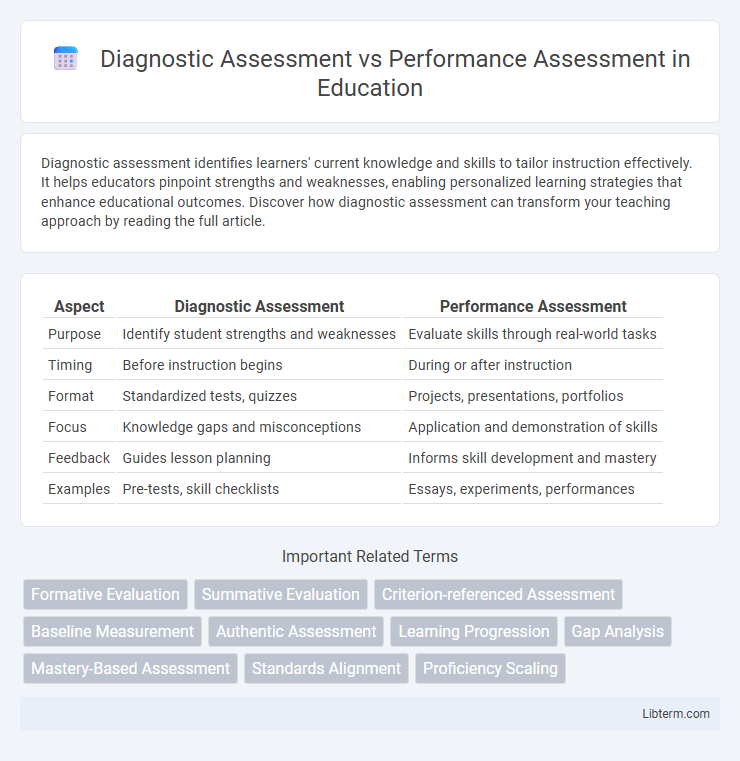Diagnostic assessment identifies learners' current knowledge and skills to tailor instruction effectively. It helps educators pinpoint strengths and weaknesses, enabling personalized learning strategies that enhance educational outcomes. Discover how diagnostic assessment can transform your teaching approach by reading the full article.
Table of Comparison
| Aspect | Diagnostic Assessment | Performance Assessment |
|---|---|---|
| Purpose | Identify student strengths and weaknesses | Evaluate skills through real-world tasks |
| Timing | Before instruction begins | During or after instruction |
| Format | Standardized tests, quizzes | Projects, presentations, portfolios |
| Focus | Knowledge gaps and misconceptions | Application and demonstration of skills |
| Feedback | Guides lesson planning | Informs skill development and mastery |
| Examples | Pre-tests, skill checklists | Essays, experiments, performances |
Introduction to Assessment Types
Diagnostic assessment identifies learners' prior knowledge and skill gaps through targeted testing, enabling personalized instruction. Performance assessment evaluates students' ability to apply knowledge in real-world or practical tasks, emphasizing critical thinking and problem-solving skills. Both assessment types serve distinct purposes, with diagnostic assessments guiding instructional planning and performance assessments measuring applied competencies.
Defining Diagnostic Assessment
Diagnostic assessment identifies individual learners' existing knowledge, skills, and misconceptions before instruction begins to tailor teaching strategies effectively. It provides detailed data on strengths and weaknesses, enabling educators to address specific learning gaps early. This contrasts with performance assessment, which measures applied skills and knowledge through tasks or projects after instruction.
Understanding Performance Assessment
Performance assessment measures students' ability to apply knowledge through tasks such as projects, presentations, or experiments, providing real-world evidence of learning. Unlike diagnostic assessment, which identifies students' strengths and weaknesses before instruction, performance assessment evaluates skills and competencies in context. This approach promotes deeper understanding and critical thinking by requiring active demonstration of mastery beyond standardized testing formats.
Key Purposes of Diagnostic Assessment
Diagnostic assessment primarily aims to identify students' prior knowledge, skills, and misconceptions before instruction begins. It provides targeted insights for educators to tailor teaching strategies and interventions effectively. This assessment type ensures personalized learning paths by pinpointing specific learning gaps and readiness levels.
Main Objectives of Performance Assessment
Performance assessment primarily aims to evaluate a learner's ability to apply knowledge and skills in real-world or practical contexts, emphasizing critical thinking, problem-solving, and creativity. It measures proficiency through tasks such as presentations, projects, or simulations, providing insights into competence beyond theoretical understanding. This approach supports personalized feedback, guiding instructional decisions and promoting continuous improvement in authentic performance.
Differences in Assessment Methods
Diagnostic assessment focuses on identifying students' prior knowledge, skills, and misconceptions through targeted questions and tests before instruction begins. Performance assessment evaluates students' ability to apply skills and knowledge by completing real-world tasks or projects, measuring practical competence. The key difference lies in diagnostic assessments being primarily formative and predictive, while performance assessments are summative and demonstrate applied learning outcomes.
Benefits of Diagnostic Assessment
Diagnostic assessment identifies students' strengths and weaknesses early, enabling tailored instruction that addresses individual learning gaps and promotes targeted skill development. This form of assessment provides educators with detailed insights into students' prior knowledge and misconceptions, supporting personalized intervention strategies that enhance learning outcomes. By pinpointing specific areas that require improvement, diagnostic assessment fosters efficient resource allocation and boosts overall academic achievement.
Advantages of Performance Assessment
Performance assessment offers a practical evaluation method that measures students' ability to apply skills and knowledge in real-world contexts, enhancing authentic learning outcomes. It encourages critical thinking, problem-solving, and creativity by requiring active demonstration rather than passive recall, making it more engaging and reflective of actual competencies. This type of assessment provides detailed insights into individual student performance, facilitating personalized feedback and targeted instructional strategies.
Choosing the Right Assessment Approach
Choosing the right assessment approach hinges on the specific goals of evaluation: diagnostic assessments pinpoint students' strengths and weaknesses before instruction, enabling targeted interventions, while performance assessments evaluate the application of knowledge and skills through real-world tasks, highlighting practical competence. Diagnostic assessments are essential for identifying learning gaps early and tailoring instruction, whereas performance assessments provide a comprehensive picture of student mastery and higher-order thinking. Selecting between these methods requires aligning assessment type with learning objectives, curriculum standards, and desired outcomes to optimize educational effectiveness.
Integrating Both Assessments for Effective Learning
Integrating Diagnostic Assessment and Performance Assessment enhances learning by identifying students' prior knowledge and skills, then applying real-world tasks to demonstrate mastery. This combined approach allows educators to tailor instruction based on diagnostic insights while evaluating students' ability to apply concepts through authentic performance metrics. Leveraging data from both assessments fosters targeted feedback and supports continuous improvement in student outcomes.
Diagnostic Assessment Infographic

 libterm.com
libterm.com